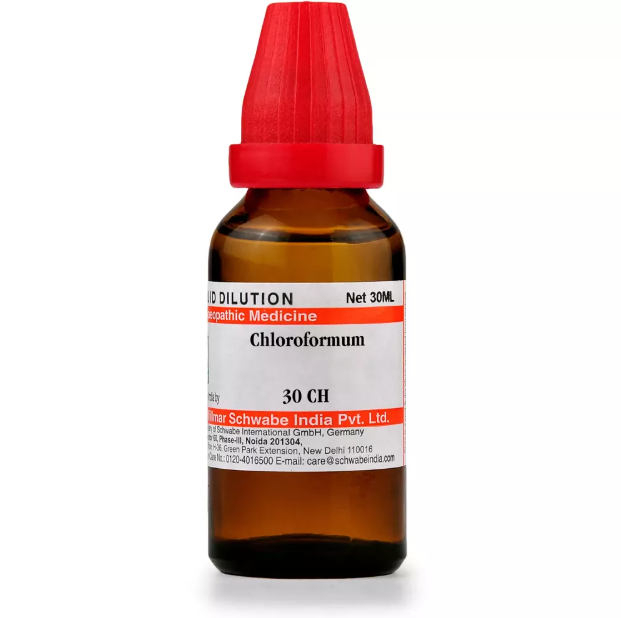CHLOROFORMIUM 6C, 12C, 30C, 200C, 1M, 10M USES AND SYMPTOMS
 CHLOROFORMIUM
CHLOROFORMIUM
Chlf.
Chloroform serves as a general anesthetic and antispasmodic, providing complete muscular relaxation. It can cause a weak and rapid pulse, shallow or noisy breathing, convulsions, nephritic or biliary colic, and gastralgia. Dr. D. Macfarlan observed these symptoms with the 6th potency.
Notable effects include great weakness, particularly on the right side, and tiredness in the limbs from the knees down. Users may experience increased perspiration on the face and chest, drowsiness, dizziness, dry lips and throat, a dry tickling cough at night, flatulence, food regurgitation, a sore and bruised feeling in the stomach, and sharp pains around the heart. There can be sharp pain on the right side of the chest during deep breaths and shortness of breath during exertion.
Head: Delirium characterized by excitement and violence. The head may be drawn down to the shoulders, with rapid opening and closing of the eyes, contracted pupils, and rapid convulsive movements of the face, muscles, and extremities (delirium tremens, tetanus, and convulsions).
Relationship:
Etherum: Post-operative bronchitis (Prof. Bier).
Spiritus aetheris compositus: Hoffman’s Anodyne (flatulence, angina pectoris). Dose: 5m to 1 dram in water.
Dose: Higher attenuations, or sixth. Phosphorus is recommended for chloroform narcosis.
SYMPTOMS OF CHLOROFORMIUM
General Symptoms:
Great weakness, especially on the right side.
Limbs feel very tired from the knees down.
Increased perspiration on the face and chest.
Drowsiness and dizziness.
Dry lips and throat.
Dry, tickling cough at night.
Flatulence.
Food regurgitation.
Sore and bruised feeling in the stomach.
Catching pain around the heart.
Sharp pain on the right side of the chest when taking a deep breath.
Shortness of breath upon exertion.
Head:
Delirium with predominant excitement and violence.
Head drawn down to the shoulders.
Eyes open and close rapidly.
Pupils contracted.
Rapid convulsive movements of the face, muscles, and extremities (as seen in delirium tremens, tetanus, and convulsions).
selection of the potency
Individualization:
- Homeopathy is based on the principle of treating the individual, not just the disease. The unique symptoms and characteristics of the person are crucial in determining the most suitable potency.
Intensity of Symptoms:
- The intensity of the symptoms guides the choice of potency. If the symptoms are intense and acute, a lower potency (e.g., 6C, 30C) might be considered. For chronic conditions with less intensity, higher potencies (e.g., 200C, 1M) may be appropriate.
Sensitivity of the Patient:
- Some individuals are more sensitive to homeopathic remedies, while others may require higher potencies. The practitioner considers the patient’s sensitivity when selecting the potency.
Acute vs. Chronic Conditions:
- Lower potencies are often used for acute conditions, while higher potencies may be considered for chronic or long-standing issues.
Previous Response to Potencies:
- The patient’s response to previous homeopathic treatments helps guide the choice of potency. If a particular potency has been effective in the past, it may be repeated or adjusted as needed.
Vital Force and Susceptibility:
- Homeopathy views illness as a disturbance in the vital force. The practitioner assesses the patient’s overall vitality and susceptibility to determine the appropriate potency.
Aggravation or Amelioration:
- The direction of the symptom response (aggravation or amelioration) after taking a remedy can influence the choice of potency.
Miasmatic Considerations:
- In classical homeopathy, the concept of miasms (inherited disease tendencies) is considered. The practitioner take this into account when selecting the potency.
Practitioner Experience:
- The experience and preference of the homeopathic practitioner play a role. Some practitioners may have success with certain potencies based on their clinical experience.
SAFETY INFORMATION
- Do not exceed the recommended dose by physician
- Keep out of the reach of children
- Store in a cool dry place away from direct sunlight
- Maintain half an hour gap between food/drink/any other medicines and homoeopathic medicine
- Avoid any strong smell in the mouth while taking medicine e.g. camphor, garlic, onion, coffee, hing
Medicine images use for reference only selection of homeopathic medicine depends on the individual’s specific symptoms and overall constitution. Moreover, homeopathy is a holistic system of medicine that treats the individual as a whole. In addition to addressing the physical symptoms, it takes into account the emotional and mental state of the person. Consequently, it’s crucial to consult with a qualified homeopathic practitioner for personalized treatment.
The information provided on this website is intended solely for educational purposes. Always seek the advice of your physician or other qualified health provider.
